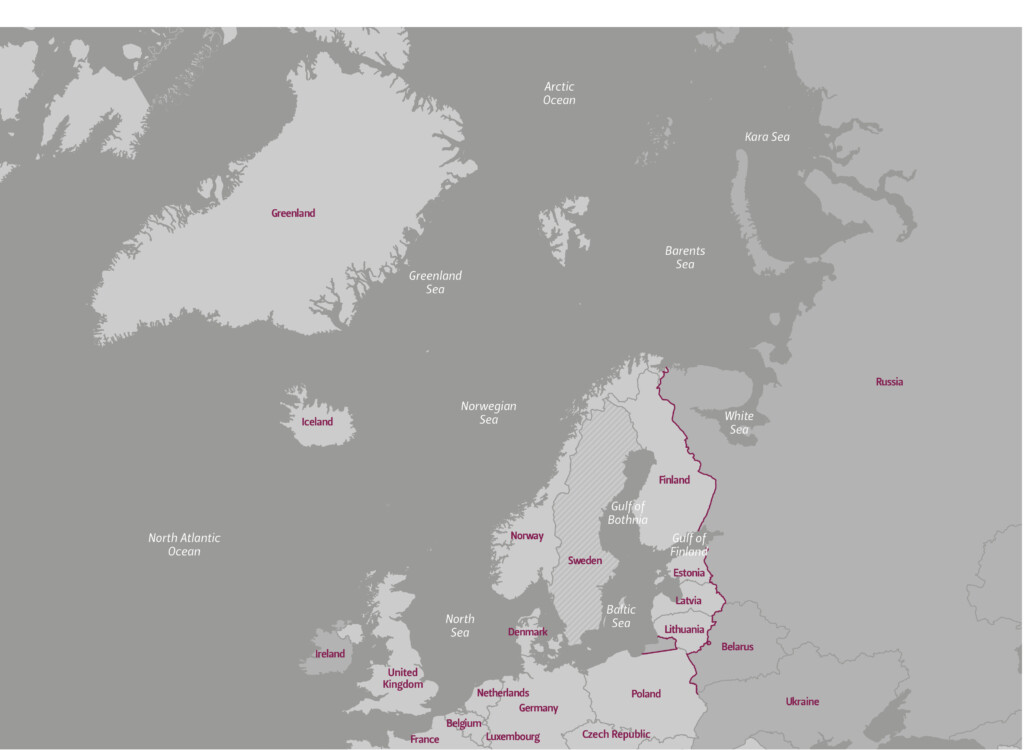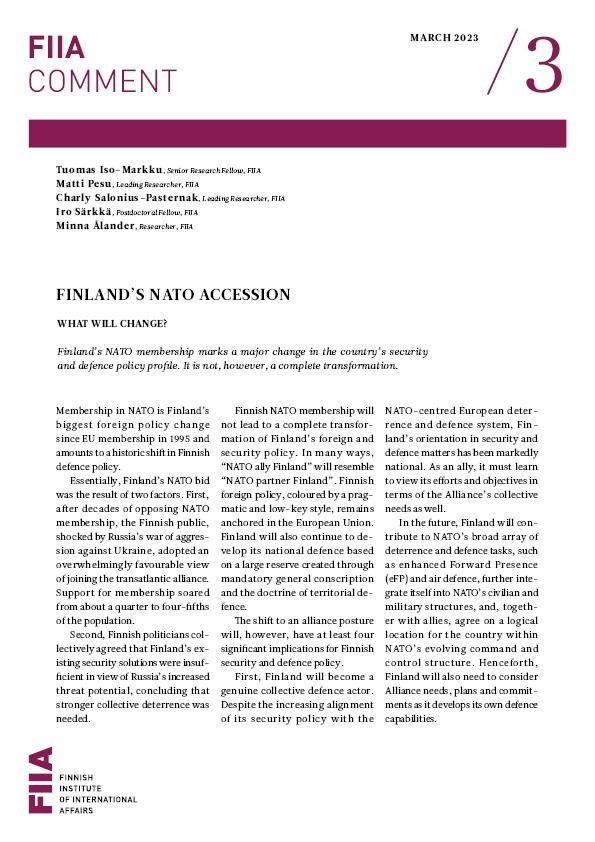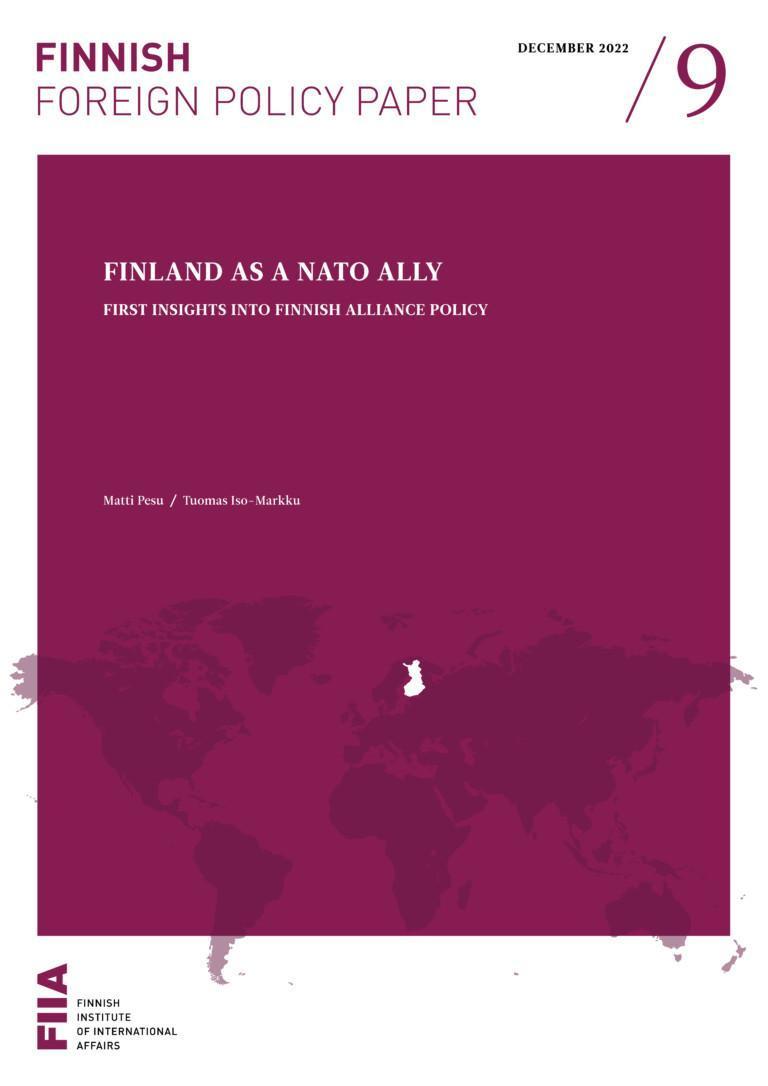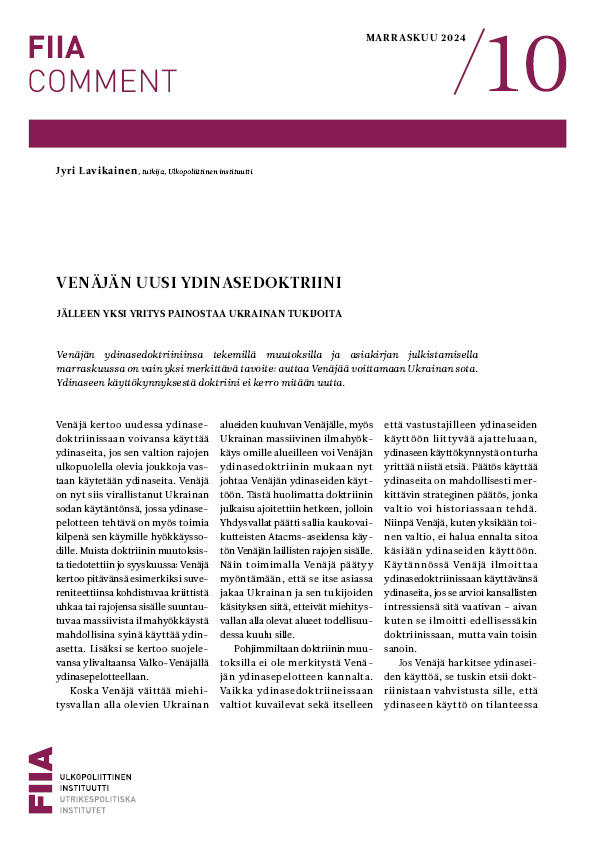The Russian war of aggression has rendered Northern Europe an increasingly significant region for Euro-Atlantic security. A stable and secure Northern Europe is a critical precondition for a safe and stable Euro-Atlantic region.
The alliance should treat Northern Europe as a strategic whole although the different subareas of Northern Europe have their distinctive security dynamics and concerns.
NATO is currently improving its deterrence and defence posture. It is simultaneously shifting its military strategy from a model of deterrence by reinforcement to one of deterrence by denial.
NATO’s evolving posture and strategy in Northern Europe should be underpinned by a more explicit division of labour. The regional allies and stakeholders can be divided into four categories in terms of their role in regional security: frontline nations, hubs, security providers and the ultimate security guarantor.
The regional frontline nations include the Baltic states, Finland and Poland, which can also play a role as hubs and even security providers along with the United Kingdom and Germany. Denmark, Sweden and Norway are first and foremost hubs. The United States remains the ultimate security guarantor of the area.
Introduction
The Northern European security architecture is in flux. As a response to the Russian war of aggression against Ukraine, NATO is bolstering its deterrence and defence posture in the region. The most notable consequence of Moscow’s full-scale invasion has, however, been Finland’s NATO accession and Sweden’s eventual entry into the alliance – a transformation that fundamentally alters the politico-military geography of Europe’s North.
These developments render Northern Europe an increasingly pertinent arena for Euro-Atlantic security. During the Cold War, the northern parts of Europe served as a side flank to the main theatre straddling Central Europe. Today, the area is a major friction point of the NATO-Russia confrontation. From a broader point of view, Northern Europe constitutes a critical buffer between Russia – the most significant and direct threat to the alliance – and the more protected NATO allies in Central and Western Europe. A stable and secure Northern Europe is therefore a critical precondition for a safe and stable Euro-Atlantic region.
This Briefing Paper delves into the evolving Northern European security landscape. It argues that in building an effective Northern European deterrence and defence posture, NATO should appreciate the geographic location and capabilities of each ally and assign them tasks for which they are best suited. The study asserts that, when it comes to Northern European security, there are four types of allies: frontline nations, hubs, security providers and a security guarantor. These four types should all have acknowledged roles in deterring and, potentially, defending against Russian military aggression.
NATO and the Northern European security landscape
NATO has been rebuilding its collective defence posture since 2014 when Russia’s first invasion of Ukraine took place. The redux of collective defence was further accelerated by Russia’s full-scale invasion in February 2022. NATO’s ongoing improvements in deterrence and defence are supported by its new military concept – the Concept for Deterrence and Defence of the Euro-Atlantic Area (DDA) – from 2020.[1] The alliance has recently approved a new force model and introduced three regional defence plans. It is also strengthening its command-and-control system.
NATO’s return to collective defence has had different manifestations in different parts of Northern Europe. The Baltic Sea region has received special attention from the alliance. In less than ten years, the alliance has established a distinctive approach to Baltic Sea security. Most notably, NATO introduced a forward presence posture in the area by deploying four multinational battalion-size battlegroups (enhanced Forward Presence, eFP) in the Baltic states and Poland in 2017. The battlegroups have mainly acted as a “tripwire” with the aim of triggering a decisive allied military response to a potential Russian invasion. NATO’s “deterrence by reinforcement” strategy in the Baltic Sea region has thus heavily relied on deploying reinforcements to repel the occupying aggressor from allied territory.[2]
Moscow’s full-scale assault against Ukraine has called into question this approach based on limited presence. Russia’s brutal atrocities in the occupied parts of Ukraine have shown that occupation comes with an unacceptable political and human price, and that Moscow must be outright prevented from taking any allied territory. At the Madrid Summit in 2022, the alliance took the first steps towards a strategy of denial – an approach in which the alliance would have the capacity to deny an attack from Russia and defend “every inch of Allied territory”. Most notably, the allies agreed to scale up the battlegroups “to brigade-size units where and when required, underpinned by credible rapidly available reinforcements, prepositioned equipment, and enhanced command and control” – an agreement that was reiterated at the Vilnius Summit in July 2023.[3] Finland’s accession to NATO will support the transformation of the alliance’s strategy as its own defence model builds on the deterrence-by-denial approach.
The credibility of the new approach will ultimately depend on how successfully allies implement their agreements, particularly the ongoing reform of NATO’s deterrence and defence posture. Furthermore, NATO’s ability to reinforce its allies remains imperative. Having enough forces at high readiness and the capacity to deploy them early enough to the theatre are vital factors in determining whether NATO is genuinely ready to deny a Russian invasion in the Baltic Sea region or elsewhere in the frontline.
Contrary to the Baltic Sea region, NATO has lacked a clear strategic approach to the European Arctic. In fact, some analysts have argued that the alliance has deterred itself from taking a more robust role in the area.[4] However, NATO and its allies have in recent years stepped up their military activities in the High North. The most notable developments have included large-scale exercises such as Trident Juncture 18 and the Norwegian-led Cold Response 2022, as well as the creation of Joint Forces Command (JFC) Norfolk in Virginia, United States. Furthermore, regional military cooperation has compensated NATO’s limited focus. Finland, Sweden and Norway have steadily intensified their collaboration on the defence of the vital Arctic land and air domains. The British-led Joint Expeditionary Force (JEF) has also identified the High North as one of its regional priorities. Furthermore, the United States has taken a more active and visible role in Arctic security, particularly in exercises. That said, NATO does not currently have forward presence in the Arctic.
Despite being distant from the frontline, the geostrategic importance of the North Sea area is also increasing. This trend is partly associated with NATO’s renewed focus on collective territorial defence. Its ports are crucial for receiving reinforcements from North America in a potential war with Russia. Additionally, the ongoing European decoupling from Russian energy and the unfolding transition to green energy further underscore the region’s strategic importance. Norway is today the largest gas supplier to Europe, and the gas pipeline network runs through the North Sea. Nine European countries are also about to multiply the capacity of offshore wind farms in the area. It is thus unsurprising that there is a growing reckoning in NATO that the alliance must step up the protection of the critical subsea infrastructure in the region.[5]
These different parts of Northern Europe are indeed distinctive in terms of their security dynamics and thus require tailored approaches from the alliance. However, the respective security situations of the Baltic Sea region, the European Arctic and the North Sea are also intimately interconnected. For example, a conflict in the Baltic Sea region could escalate to the High North, and the Arctic waters and the Northern Sea would again be needed for reinforcing the Baltic Sea region. Importantly, from Russia’s point of view, its north-western direction constitutes one theatre of operations, and it has no political constraints in dealing with the region as one strategic entity.
Finland’s and Sweden’s NATO accession further underscores the interdependent nature of different parts of Northern Europe. The alliance cannot address the respective security concerns of these new allies without taking into account the Baltic Sea region, the European Arctic and, in Sweden’s case, also the North Sea. The bottom line is that NATO must increasingly treat Northern Europe as one strategic area. In practical terms, the alliance should regularly carry out Northern European-wide military exercises. The alliance should also ensure that the military plans and command-and-control arrangements regarding the region are as seamless as possible.

Figure 1. NATO member states and the Northern European security landscape
A more explicit division of labour
Due to Finland’s and Sweden’s entry into the alliance, NATO is now well placed to address Northern European security concerns. Finland and Sweden will be integrated into NATO’s military structure – its operations planning, force structure and command-and-control system. Furthermore, different security policy solutions no longer limit the depth of regional military cooperation. Interestingly, given these permissive conditions, the alliance is now able to consider a more explicit division of labour in the Northern European security milieu. In this new situation, NATO should more clearly acknowledge the strengths and functional roles of individual allies that stem from their geographic location and military capabilities.
NATO’s evolving regional posture as well as the ongoing shift in its military strategy should be guided by the spirit of its Cold War strategic concepts. According to the concept from 1949, “each nation should undertake the task, or tasks, for which it is best suited”, and “certain nations, because of geographic location or because of their capabilities, will appropriate specific missions.”[6] These different roles and responsibilities should be reflected in NATO’s regional defence plans, its force development and capability targets, as well as peacetime collective defence missions. This would not mean deviating from NATO’s 360-degree approach to security threats, which also include terrorism. Nor would it mean ignoring the alliance’s two other core tasks, namely crisis prevention and management as well as cooperative security. Every ally should be able to contribute to all NATO’s core tasks in the alliance’s area of responsibility.
When it comes to geography and capabilities, Northern European allies can be categorized in several, not mutually exclusive, ways.[7] First, there are frontline nations that share a border with Russia or Belarus and are thus most exposed to a potential military aggression. They should therefore commit most of their resources and efforts to defend the frontline of NATO. The regional frontline nations include the Baltic states, Poland and Finland. Norway also shares a border with Russia, but its role as a frontline nation is less distinctive.
Second, hubs are more protected nations whose main role is to act as reception or staging areas for military operations in the frontier. Furthermore, hubs should also be able to offer military support for their more vulnerable allies. In the Northern European theatre, Sweden, Norway and Denmark can be seen as hub nations.
Third, security providers are again more powerful nations that, in addition to acting as vital hubs, can offer full-spectrum military support for their allies. In Europe’s North, Germany and the United Kingdom are seen as the primary security providers although particularly Germany is also a critical hub for the alliance. Lastly, there is a security guarantor that provides strategic insurance – extended deterrence – for all regional allies. In the Northern European theatre, the guarantor is the United States, which remains an unparalleled global military superpower.
Naturally, the list of contributing allies is not exhaustive. Several allies, such as France, the Netherlands and Canada, already play a substantial role in the region. More than 20 NATO members also contribute to the four regional battlegroups. Moreover, the above categories are not mutually exclusive. Frontline nations can also provide support for their allies, and security providers can provide critical hub functions for allied activities in the region.
Evolving allied roles in Europe’s North
Finland’s role as a frontline nation is indisputable. Its land border with Russia is longer than that of any other ally. More importantly, Finland is located close to two vital Russian strategic locations – the St. Petersburg region and Kola Peninsula. Finland’s ability to defend its territory directly protects Northern Sweden and the critical coasts of Northern Norway, which are needed to control the North Atlantic sea lines. The defence of these vital maritime routes thus starts from Finnish Lapland. Furthermore, the Finnish territory provides NATO with additional strategic depth for defending the Baltic states, particularly Estonia. As a new ally, Finland must be particularly mindful of developing its capacity to receive and host allied reinforcements.
For Sweden, NATO membership may result in a major transformation in its national defence identity. During the Cold War, as a non-aligned country, Sweden built a formidable defence capacity aimed at denying Soviet armed aggression through Finland and across the Baltic Sea. As a NATO ally, it will primarily act as a staging area, facilitating onward-moving reinforcements for operations in Finland and the Baltic states. This role as a hub would also entail acquiring capabilities and functions that would directly and indirectly support the defence of frontline nations, particularly in the land theatre of the European Arctic.[8]
Norway’s clear priority remains the maritime domain of the European Arctic. It has a long coastline, and the adjacent sea areas constitute a vital buffer against Russian naval operations in the North Atlantic. Although its border with Russia makes it a frontline nation, it is also increasingly a hub facilitating allied operations in the frontline. For the first time, Norway shares a land border with its allies, which improves Norwegian security. However, it also means that it is no longer the sole destination of allied reinforcements in the North but also a reception area for forces moving towards the frontline. Indeed, its role in securing free sea lanes and facilitating allied reinforcements will gain importance.[9]
Denmark is currently rebuilding its territorial capabilities. From a geostrategic point of view, as during the Cold War, it remains the guardian of the Danish straits, which connect the Baltic Sea to the North Sea and the Atlantic Ocean. It therefore plays a significant role in defending the sea lines in its adjacent sea areas. This is a task that demands considerable naval capabilities. Unlike during the Cold War, Denmark is not a frontline nation. Rather, it is a hub, offering a potential transit and base area for allied forces. It could also provide direct support for allies, most notably the Baltic states. Currently, its troops are present in Estonia and Latvia, and it is one of the framework nations of Headquarters Multinational Division North in Latvia.[10]
The Baltic states are frontline nations and, by virtue of their size, most vulnerable to the threat from Russia. Together, Estonia, Latvia and Lithuania share a 508-kilometre border with Russia. Their territorial integrity not only helps NATO keep the Baltic Sea routes open for navigation but also serves as a vital security interest for allies such as Finland, Sweden, Poland and Denmark as it adds crucial strategic depth in relation to Russia. Given their precarious strategic location and limited national resources, their defence requires a strong commitment from NATO allies. Their role in the Northern division of labour should be local, with the focus on acquiring capabilities that would make a potential invasion as costly as possible and ensuring that they have the capacity to receive and host allied reinforcements.
Poland has historically had a perilous geostrategic location between continental powers and Russia. Today, despite being much better off in terms of its security, Poland still has major geostrategic significance in the Baltic Sea theatre. Importantly, Poland has rapidly become a hub for allied, particularly American, presence and operations on NATO’s eastern flank. It is also a frontline nation bordering Moscow’s ally Belarus, the Kaliningrad exclave and Ukraine, where the Russian aggression is currently taking place. The strategically vital Suwałki Gap – NATO’s only land corridor to the Baltic states – is also located in the north-eastern corner of Poland. Warsaw is planning to make significant investments in its military capabilities, and, should these plans be realized, Poland could even become the strongest allied land power in Europe.[11] This would naturally raise expectations towards Warsaw to also take a stronger role as a security provider for smaller NATO allies in its vicinity.
Germany is a Baltic Sea littoral state and a vital hub in the Northern European security milieu. Due to the Cold War legacy, Germany is a major military hub for US forces in Europe. It is also a critical transit route, facilitating the flow of allied reinforcements to the eastern flank. In addition to being a critical rear area, Germany should be a leading security provider for Northern Europe. In the land domain, it is one of the NATO members who have the potential to reinforce their allies above brigade and division level. Its ambition is to provide three mechanized divisions to NATO’s defence planning process by 2031. Furthermore, it is currently the only ally who is committed to permanently station troops in the frontline, namely in Lithuania. Germany also has the potential to play a strong naval role in the Baltic Sea. It already has by far the biggest navy of the eight Baltic Sea NATO allies, but it could provide not only additional capabilities but also leadership in the maritime defence of the region.[12]
The United Kingdom’s location in the Northern Atlantic makes it an essential stakeholder of and contributor to Northern European security. It is foremost a security provider for its allies in Europe’s North. Britain has demonstrated its leadership through the Joint Expeditionary Force (JEF) as well as the Northern Group. Nuclear weapons, which it has assigned to the defence of NATO, make the UK a distinctive ally. Furthermore, the UK has demonstrated its capability to operate in different parts of Northern Europe from the Baltic Sea to the European Arctic and Northern Sea. It is a framework nation for the eFP battlegroup in Estonia, and it has an essential role in supporting the development of Estonia’s national divisional headquarters. Britain has also recently established Camp Viking in Northern Norway as an operations base for UK commandos in the Arctic. The Royal Airforce and the Royal Navy regularly take part in military exercises in different parts of Northern Europe.
The United States remains the security guarantor of its Northern European allies. Its nuclear forces constitute the supreme guarantee of the NATO alliance, and its allies treat the US as an indispensable provider of military support and reinforcements in all domains. Its role is particularly critical in areas such as long-range fires as well as intelligence, surveillance and reconnaissance (ISR). Its allies expect the US to take a leading role should a conflict with Russia erupt. However, although the US has impressively led the Western response to Russia’s war of aggression, and it treats Russia as an acute security threat, Washington increasingly sees Europe as a secondary theatre in comparison to the Indo-Pacific region. One aim of creating a more efficient division of labour is to ease the American burden in the regional security landscape. If European allies can bear the primary responsibility of the conventional defence of Northern Europe, the US could focus on certain key capabilities such as air power and long-range fires as well as critical enablers such as ISR.
Conclusion
This Briefing Paper has argued that the importance of Northern Europe in Euro-Atlantic defence is growing. The region consists of several subareas such as the Baltic Sea, the European Arctic and the North Sea, which are characterized by idiosyncratic security dynamics. However, the Northern European security landscape should increasingly be seen as a single coherent theatre at the forefront of the NATO-Russia confrontation. Finland’s NATO accession and Sweden’s upcoming entry underscore this reality.
The study has also presented the argument that NATO’s evolving Northern European posture should more explicitly acknowledge a division of labour among the regional allies and stakeholders. Given the fact that the allies are different by virtue of their geographic location and capabilities, the alliance should assign them tasks for which they are best suited. Importantly, this logic could also be utilized elsewhere in NATO’s area of responsibility.
Although the recognition of the potential division of labour stems from a sound military logic, it is not necessarily entirely congruent with NATO’s current political logic, which highlights a 360-degree approach to threats in all strategic directions of the alliance. Considering the security concerns of all allies is indeed vital for alliance cohesion and unity. However, appreciating the differences of allies does not imply discarding the 360-degree approach or NATO’s two other core tasks: crisis prevention and management and cooperative security. Rather, it makes the implementation of NATO’s first core task more efficient. It would also reflect the fact stated in the new strategic concept that Russia is the greatest threat to the Euro-Atlantic region.
Indeed, NATO’s return to collective defence requires area-specific solutions, and, in fact, the adoption of new regional plans suggests that the alliance is increasingly seeing the Euro-Atlantic space in regional terms. The political logic of the alliance must more clearly follow the military logic, which mainly stems from geography. Allies can well have more distinctive roles and a more explicit division of labour without threatening the unity of the alliance.
Endnotes
[1] See Covington, Stephen R. (2023) “NATO’s Concept for Deterrence and Defence of the Euro-Atlantic Area (DDA)”. Belfer Center for Science and International Affairs, Harvard Kennedy School, 2 August 2023, https://www.belfercenter.org/publication/natos-concept-deterrence-and-defence-euro-atlantic-area-dda.
[2] Hagström-Frisell, Eva (ed.) (2019) “Deterrence by Reinforcement: The Strengths and Weaknesses of NATO’s Evolving Defence Strategy”. FOI-R--4843—SE, November 2019, Swedish Defence Research Agency, https://www.foi.se/rest-api/report/FOI-R--4843--SE.
[3] Madrid Summit Declaration Issued by NATO Heads of State and Government, 29 June 2022, https://www.nato.int/cps/en/natohq/official_texts_196951.htm; Vilnius Summit Communiqué Issued by NATO Heads of State and Government, 11 July 2023, https://www.nato.int/cps/en/natohq/official_texts_217320.htm.
[4] Mikkola, Harri, Samu Paukkunen and Pekka Toveri (2023) “Russian aggression and the European Arctic: Avoiding the trap of Arctic exceptionalism”. FIIA Briefing Paper 359, April 2023, The Finnish Institute of International Affairs, https://fiia.fi/julkaisu/russian-aggression-and-the-european-arctic.
[5] Ministry of Defence, “UK and Norway to increase cooperation on undersea capabilities”. Press release, 18 May 2023, https://www.gov.uk/government/news/uk-and-norway-to-increase-cooperation-on-undersea-capabilities.
[6] Mattelaer, Alexander (2018) “Rediscovering geography in NATO defence planning”. Defence Studies 18 (3): 339–356, https://doi.org/10.1080/14702436.2018.1497446.
[7] The categories are partly drawn from Simón, Luis, Alexander Lanoszka and Hugo Meijer (2021) “Nodal defence: The changing structure of U.S. alliance systems in Europe and East Asia”. Journal of Strategic Studies 44 (3): 360–388, https://doi.org/10.1080/01402390.2019.1636372.
[8] Neretnieks, Karlis (2022) “Burden Sharing and Specialization After Sweden and Finland’s NATO Accession”. Stockholm Free World Forum, 25 September 2022, https://frivarld.se//data/wordpress/htdocs/wp-content/uploads/2022/09/Karlis-SISTA-UTKAST-1-1.pdf. See also Swedish Defence Commission (2023) Allvarstid – Försvarsberedningens säkerhetspolitiska rapport. Ds 2023:19, 198–202, https://www.regeringen.se/contentassets/de808e940116476d8252160c58b78bb7/allvarstid-ds-202319.pdf.
[9] Norwegian Defence Commission (2023) “Forsvar for fred og frihet”. Norges offentlige utredninger 2023: 14, 88–89.
[10] See, e.g., Clemmesen, Michael Hesselholt (2023) “Danish Thoughts on Finnish and Swedish NATO Membership”. Stratagem, 31 March 2023, https://www.stratagem.no/danish-thoughts-on-finnish-and-swedish-nato-membership/.
[11] Day, Matthew (2023) “Poland builds Europe’s largest land force to counter Russian threat”. The Telegraph, 11 March 2023, https://www.telegraph.co.uk/world-news/2023/03/11/revolution-polish-army-builds-europes-largest-land-force/.
[12] Gehle, Sarah (2023) “The German Navy’s long-distance vision gains clarity”. IISS Military Balance Blog, 21 April 2023, https://www.iiss.org/online-analysis/military-balance/2023/04/the-german-navys-long-distance-vision-gains-clarity/; Barry, Ben, Henry Boyd, Bastian Giegerich et. al. (2023) “The Future of NATO’s European Land Forces: Plans, Challenges, Prospects”. IISS Research Papers, 27 June 2023, https://www.iiss.org/research-paper/2023/06/the-future-of-natos-european-land-forces/.









